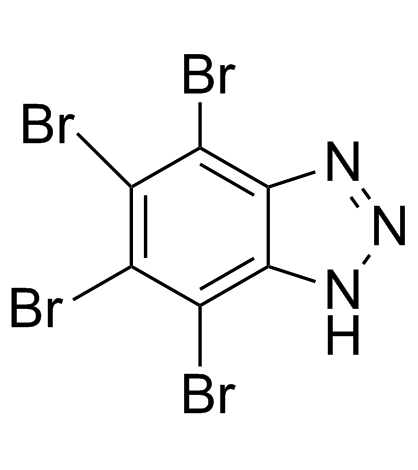TBB

TBB structure
|
Common Name | TBB | ||
|---|---|---|---|---|
| CAS Number | 17374-26-4 | Molecular Weight | 434.708 | |
| Density | 2.8±0.1 g/cm3 | Boiling Point | 552.5±45.0 °C at 760 mmHg | |
| Molecular Formula | C6HBr4N3 | Melting Point | 262-266ºC | |
| MSDS | USA | Flash Point | 288.0±28.7 °C | |
|
ATG16L1 phosphorylation is oppositely regulated by CSNK2/casein kinase 2 and PPP1/protein phosphatase 1 which determines the fate of cardiomyocytes during hypoxia/reoxygenation.
Autophagy 11 , 1308-25, (2015) Recent studies have shown that the phosphorylation and dephosphorylation of ULK1 and ATG13 are related to autophagy activity. Although ATG16L1 is absolutely required for autophagy induction by affecting the formation of autophagosomes, the post-translational ... |
|
|
Casein Kinase 2 Negatively Regulates Abscisic Acid-Activated SnRK2s in the Core Abscisic Acid-Signaling Module.
Mol. Plant 8 , 709-21, (2015) SnRK2 kinases, PP2C phosphatases and the PYR/PYL/RCAR receptors constitute the core abscisic acid (ABA) signaling module that is thought to contain all of the intrinsic properties to self-regulate the hormone signal output. Here we identify Casein Kinase (CK)... |
|
|
Identification of malaria parasite-infected red blood cell surface aptamers by inertial microfluidic SELEX (I-SELEX).
Sci. Rep. 5 , 11347, (2015) Plasmodium falciparum malaria parasites invade and remodel human red blood cells (RBCs) by trafficking parasite-synthesized proteins to the RBC surface. While these proteins mediate interactions with host cells that contribute to disease pathogenesis, the inf... |
|
|
Valsartan Upregulates Kir2.1 in Rats Suffering from Myocardial Infarction via Casein Kinase 2.
Cardiovasc. Drugs Ther. 29 , 209-18, (2015) Myocardial infarction (MI) results in an increased susceptibility to ventricular arrhythmias, due in part to decreased inward-rectifier K+ current (IK1), which is mediated primarily by the Kir2.1 protein. The use of renin-angiotensin-aldosterone system antago... |
|
|
Members of the Plant CRK Superfamily Are Capable of Trans- and Autophosphorylation of Tyrosine Residues.
J. Biol. Chem. 290 , 16665-77, (2015) Protein phosphorylation on Tyr residues is a key post-translational modification in mammals. In plants, recent studies have identified Tyr-specific protein phosphatase and Tyr-phosphorylated proteins in Arabidopsis by phosphoproteomic screenings, implying tha... |
|
|
PBDEs and other POPs in urban birds of prey partly explained by trophic level and carbon source.
Sci. Total Environ. 524-525 , 157-65, (2015) As urban sprawl and agricultural intensification continue to invade prime wildlife habitat, some animals, even apex predators, are managing to adapt to this new environment. Chemical pollution is one of many stressors that wildlife encounter in urban environm... |
|
|
Suppression of casein kinase 2 sensitizes tumor cells to antitumor TRAIL therapy by regulating the phosphorylation and localization of p65 in prostate cancer.
Oncol. Rep. 34 , 1599-604, (2015) In the United States, prostate cancer (PCa) is the most commonly diagnosed cancer in males. For PCa at the late hormone-refractory stage, substantial improvement in treatment strategies is critically needed. TNF-related apoptosis-inducing ligand (TRAIL) is a ... |
|
|
Molecular Profiling in Lung Biopsies of Human Pulmonary Allografts to Predict Chronic Lung Allograft Dysfunction.
Am. J. Pathol. 185 , 3178-88, (2015) Chronic lung allograft dysfunction (CLAD) is the main reason for poor long-term outcome of lung transplantation, with bronchiolitis obliterans (BO) representing the predominant pathological feature. BO is defined as a progressive fibrous obliteration of the s... |
|
|
Modulation of LSD1 phosphorylation by CK2/WIP1 regulates RNF168-dependent 53BP1 recruitment in response to DNA damage.
Nucleic Acids Res. 43 , 5936-47, (2015) Proper DNA damage response is essential for the maintenance of genome integrity. The E3 ligase RNF168 deficiency fully prevents both the initial recruitment and retention of 53BP1 at sites of DNA damage. In response to DNA damage, RNF168-dependent recruitment... |
|
|
Inhibition of protein kinase CK2 closes the CFTR Cl channel, but has no effect on the cystic fibrosis mutant deltaF508-CFTR.
Cell Physiol. Biochem. 24(5-6) , 347-60, (2009) Deletion of phenylalanine-508 (DeltaF508) from the first nucleotide-binding domain (NBD1) in the wild-type cystic fibrosis (CF) transmembrane-conductance regulator (wtCFTR) causes CF. However, the mechanistic relationship between DeltaF508-CFTR and the divers... |